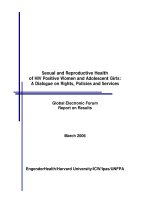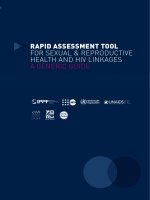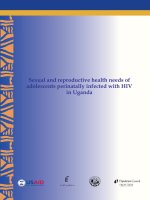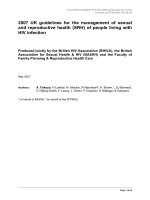Integrating sexual and reproductive health into health emergency and disaster risk management doc
Bạn đang xem bản rút gọn của tài liệu. Xem và tải ngay bản đầy đủ của tài liệu tại đây (633.46 KB, 4 trang )
Background
Emergencies and large-scale disasters have significant impact on public
health, health infrastructure and the delivery of health care. More than
1.1 million deaths were recorded in over 4000 large-scale natural disasters in
the past decade
1
while an average of over 220 million people were affected
each year.
2
More than 1.5 billion people live in countries affected by fragility,
conflict or large-scale violence.
3
In 2012, it is estimated at least 51 million
people in 16 countries require some form of humanitarian assistance.
4
This
is not the full picture, as numerous other emergencies, including epidemics,
chemical and radiological incidents, and major transport crashes, also affect
public health particularly at the local level, but often with national and interna-
tional dimensions too. Economic losses from these events run into the billions
of dollars, setting back social development and hard-earned health gains.
Emergencies have a disproportionate effect on the poorest and most vulner-
able, particularly women and children. Eight of the ten countries with the
highest maternal mortality ratios in the world are in fragile circumstances
and are affected by current or recent conflict.
5
Neonatal mortality rates are
highest in areas affected by humanitarian emergencies.
6
Given the high HIV
prevalence in countries at risk or facing emergencies, a significant proportion
of people affected by emergencies are living with HIV. Emergencies linked
to displacement, food insecurity and poverty, increase vulnerability to HIV
and negatively affect the lives of those already living with HIV.
7
Population
pressures, combined with poorly planned urban and rural development and
climate change, make communities more vulnerable to, and increase the risk
of, emergencies and disasters.
Sexual and reproductive health (SRH) is a significant public health need
in all communities, including those facing emergencies. As stated in the
outcome document of the Rio+20 United Nations Conference on Sustainable
Development, universal access to reproductive health, including family plan-
ning and sexual health, is needed and should be integrated into national
strategies and programmes.
8
In emergency situations, there is often a lack of access to SRH services.
These services need to be strengthened in preparation for future events to
reduce SRH-related morbidity and mortality in times of emergencies.
This policy brief discusses the integration of SRH in all aspects of health
emergency and disaster risk management, both for immediate health needs,
such as saving lives in obstetric complications and preventing disease, as well
in the long-term to reduce vulnerability and to support sustainable develop-
ment of health systems and communities.
Policy Brief
Integrating sexual and reproductive health into
health emergency and disaster risk management
Sexual and
reproductive
health (SRH) is a
significant public
health need in all
communities,
including
those facing
emergencies
October 2012
Integrating sexual and reproductive health into health emergency and disaster risk management
Health emergency and disaster risk
management
A multisectoral and multidisciplinary health emergency and
disaster risk management system protects public health and
reduces morbidity, mortality and disability associated with
emergencies through effective prevention, preparedness,
response and recovery measures. While traditionally the
health sector has focused on the emergency response, the
ongoing challenge is to take a more proactive approach
that builds community and country capacities to prevent
emergencies, where possible, as well as being prepared for
emergencies in advance with timely and effective response
and recovery services.
Health systems based on primary care at the community
level:
• reduce the vulnerability of at-risk populations before an
emergency occurs
• build the capacity of communities to prevent, prepare,
respond to and recover from emergencies, thus protecting
public health, health services and infrastructure
• provide the basis for scaling-up measures to meet wide-
ranging health needs in emergencies
• prevent avoidable morbidity and mortality, particularly
among women, children and adolescents
• utilize the opportunities in the recovery phase to
strengthen services and reduce risk of future events.
These measures help build the resilience of health systems
to emergencies and disasters and support the implementa-
tion of the Hyogo Framework of Action
9
which identifies
priority areas for action to build national and community
resilience to disasters.
Sexual and reproductive health: a public
health priority
The leadership role of national and local authorities, com-
munities and beneficiaries in ensuring access to SRH
services should be recognized and supported from policy
formulation, through the development of action plans and in
the design and delivery of services. Partnerships at global,
regional and country levels have a fundamental responsibil-
ity to support and strengthen the capacity of national and
local actors and ensure ownership and acceptability of
programmes by communities and individuals.
10
Key SRH interventions include:
• Family planning (all methods - including long-term and
permanent, as well as emergency contraception)
• Safe abortion care to the full extent of the law and post-
abortion care
• Pregnancy care
• Childbirth care (including emergency obstetric care)
• Postnatal care (mother and newborn)
• Prevention and management of sexually transmitted
infections and HIV, including mother-to-child
transmission of HIV and syphilis
• Prevention and management of gender-based violence
An integrated approach to the planning and delivery of SRH
services (e.g. strengthening the linkages between HIV and
other services) optimizes resources and maximizes opportu-
nities for improving universal access to SRH in communities,
including during emergencies.
Programme implementers and managers should remember that:
• Reproductive health is a human right.
• Sexual and reproductive health (SRH) is a significant public health issue, including in emergencies.
• A range of adverse outcomes can be prevented by timely provision of SRH services before, during and after
emergencies.
• Sufficient numbers of trained health-care workers and adequate facilities and supplies are essential for SRH
service delivery.
• SRH should be promoted as a fundamental component of primary health care at all times.
• The Minimum Initial Service Package (MISP)
11
for Reproductive Health is standard for essential health services
in crises, according to the internationally recognized humanitarian charter, the Sphere Project.
12
The MISP is a
coordinated set of priority activities for decreasing SRH-related morbidity and mortality during an emergency.
• The MISP should be implemented, and built on, from the early stages of a crisis, and does not require a needs
assessment prior to implementation.
• In emergencies, communities are the first responders and can identify pregnant women and survivors of sexual
violence and support them in getting the care they need.
Integrating sexual and reproductive health into health emergency and disaster risk management
In emergency situations where demands on health services
are high and time and resources are limited, SRH services
are prioritized on the basis of saving lives, optimizing scarce
resources and responding to the needs of the affected
community. The Minimum Initial Services Package (MISP)
11
describes the key SRH priorities that are expected in
emergencies:
• Identify an organisation(s) and individual(s) to facilitate
the coordination and implementation of the MISP
• Prevent and manage the consequences of sexual
violence
• Reduce HIV transmission
• Prevent excess maternal and neonatal morbidity and
mortality
• Plan for the provision of comprehensive reproductive
health services, integrated into primary health care, as
soon as possible.
Management of sexual and reproductive
health for emergencies
The Hyogo Framework for Action identifies priority actions
before an emergency across all sectors; the MISP recom-
mends priority SRH activities during an emergency; and the
Granada Consensus builds from the emergency response to
identify priorities for action in protracted crises and recov-
ery.
10
Health policymakers, emergency managers in health
and other sectors, donors and other actors are advised to
consider the following actions to integrate SRH into emer-
gency risk management systems, programmes and plans:
• Priority 1: Incorporate SRH into multisectoral and
health emergency risk management policies and
plans at national and local levels. Allocate human and
financial resources to integrate SRH into the national
health emergency risk management programmes as part
of national plans of action for risk reduction (including
preparedness) and in emergency response and recovery
plans. Assure SRH services are part of national health
policies and stable primary healthcare systems, which
builds resilience and capacity for emergencies.
• Priority 2: Integrate SRH into health risk assessment
and provide early warning for communities and
vulnerable groups. Incorporate assessments of SRH
risks, vulnerabilities and capacities at all levels, informed
by poverty, gender and disability analyses. Estimate
the impact of identified SRH risks (such as vulnerable
populations, high percentage of home deliveries, or
lack of access to vehicles for obstetric and newborn
complications) to strengthen the overall primary
health-care system and plan for emergency response
to address these concerns. Involve vulnerable groups
in the development and implementation of community
early warning systems, ensuring that their needs are
addressed and that systems are gender-responsive.
• Priority 3: Create an environment of learning and
awareness. Foster an awareness of key SRH risks
and actions within a culture of improving community
health, safety and resilience at all levels. Include health
emergency risk management, including risk assessment,
vulnerability reduction, emergency response planning
and the MISP in the curricula for SRH workers, and for
the broader health emergency management community.
Strengthen media advocacy on the importance of
maintaining SRH services during a response.
• Priority 4: Identify and reduce risks for vulnerable
communities and SRH services by reducing
underlying risk factors. Address underlying health
vulnerabilities of the population by ensuring strong
primary health care and preventive health measures
with key provisions for SRH (and advance gender
equality). Establish community networks to monitor local
vulnerabilities and capacities, build all health facilities to
withstand local hazards and ensure that these facilities
remain functional to provide SRH services, including care
for childbirth and obstetric and newborn complications
during emergencies.
• Priority 5: Prepare existing SRH services to absorb
impact, adapt, respond to and recover from
emergencies. Adopt specific policies for the inclusion
of vulnerable populations (women, adolescents,
newborn, displaced and disabled people) that reflect risk
assessment, gender and other analyses into disaster
preparedness planning. Pre-position reproductive
health kits, maintain vehicles to be used for referral of
complications, and enact clear policies and procedures
for coordination at all levels to ensure a comprehensive,
well-coordinated response.
The development and implementation of health emergency
response plans at all levels should include provisions for the
MISP. During disaster recovery, a plan should be made for
sustainable consolidation and expansion of SRH services
based on local needs and context as soon as the situa-
tion permits. After the acute phase of an emergency, SRH
services should be adjusted to address recovery, restoration
and quality improvement according to local contextual and
health system capacities.
10
Next Steps
Although steps have been taken to integrate SRH into health emergency risk management, especially in emergency re-
sponse, it is not done systematically in all countries and contexts. Additionally, it is critical to document concrete examples
and lessons learned from implementation of SRH within prevention and preparedness efforts, as well as response and re-
covery. Developing this evidence base will facilitate the development of SRH knowledge and good practices, and contribute
to the strengthening of SRH services to manage the health risk associated with emergencies. Efforts to strengthen health
emergency risk management systems, including SRH services, require a sustained investment of resources for building
capacities and delivering services to meet the needs of populations at risk of emergencies.
References
1. Towards a post-2015 framework for disaster risk reduction. Geneva, United Nations International Strategy for Disaster Reduction, 2012
( />2. EM-DAT: The OFDA/CRED International Disaster Database [online database]. Brussels, Centre for Research on the Epidemiology of Disasters -
CRED, 2010 (www.emdat.be).
3. World development report 2011: conflict, security, and development. Washington, World Bank, 2011.
4. Amos V. Under-Secretary-General for Humanitarian Affairs and Emergency Relief Coordinator [press briefing]. Geneva, United Nations Office for the
Coordination of Humanitarian Affairs, 2011.
5. Trends in maternal mortality: 1990 to 2008. Geneva, WHO, UNICEF, UNFPA, & The World Bank, 2010.
6. Lam JO, Amsalu R, Kerber K, Lawn JL, Tomczyk B et al. Neonatal survival interventions in humanitarian emergencies: a survey of current practices
and programs. Conflict and Health2012,6:2doi:10.1186/1752-1505-6-2.
7. Interagency Standing Committee (IASC), Guidelines for Addressing HIV in Humanitarian Settings. Geneva, UNAIDS, 2010.
8. The future we want: Outcome document adopted at Rio+20. New York, Department of Public Information, United Nations, 2012
( />9. Hyogo Framework for Action (2005-2015): Building the resilience of nations and communities to disasters. Geneva, United Nations Office for
Disaster Risk Reduction, 2005 ( />10. Granada Consensus on Sexual and Reproductive Health in Protracted Crises and Recovery. Statement developed at the Consultation on
Sexual and Reproductive Health in Protracted Crises and Recovery in Granada, Spain, 28-30 September 2009.
( />11. The Minimum Initial Services Package (MISP) for Reproductive Health in Crisis Situations. Reproductive Health Response in Crisis Consortium, 2012.
( />12. Humanitarian Charter and Minimum Standards in Humanitarian Response. Geneva, Sphere Project, 2011 ( />WHO/RHR/12.32
© World Health Organization 2012
The designations employed and the presentation of the material in this publication do
not imply the expression of any opinion whatsoever on the part of the World Health
Organization concerning the legal status of any country, territory, city or area or of its
authorities, or concerning the delimitation of its frontiers or boundaries.
The mention of specific companies or of certain manufacturers’ products does not imply
that they are endorsed or recommended by the World Health Organization in preference
to others of a similar nature that are not mentioned. Errors and omissions excepted, the
names of proprietary products are distinguished by initial capital letters.
All reasonable precautions have been taken by the World Health Organization to verify
the information contained in this publication. However, the published material is being
distributed without warranty of any kind, either expressed or implied. The responsibility
for the interpretation and use of the material lies with the reader. In no event shall the
World Health Organization be liable for damages arising from its use.
For more information, please contact the following
WHO departments:
Reproductive Health and Research
E-mail:
www.who.int/reproductivehealth
Maternal, Newborn, Child and Adolescent Health
E-mail:
www.who.int/maternal_child_adolescent
Emergency Risk Management and Humanitarian Response
E-mail:
www.who.int/disasters
World Health Organization
Avenue Appia 20,
CH-1211 Geneva 27, Switzerland
This Policy Brief was developed by the Reproductive Health Sub-working Group of the ISDR/WHO Thematic Platform for
Disaster Risk Management for Health. Factsheets on thematic areas of disaster risk management for health are available at:
www.who.int/hac/techguidance/preparedness/factsheets









